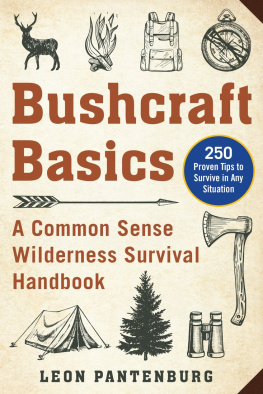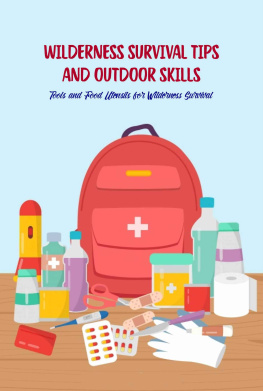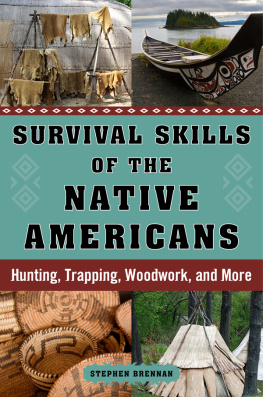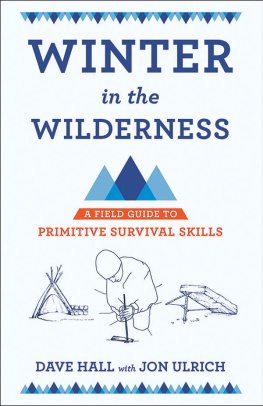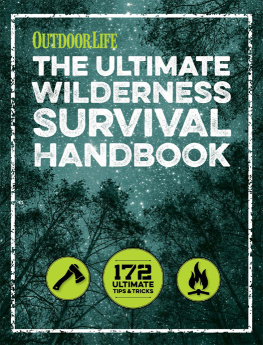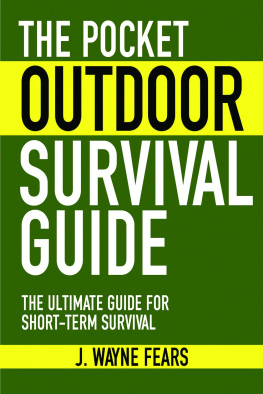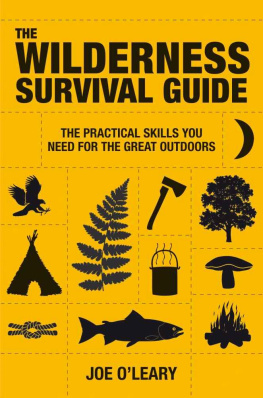Contents
Guide

The author and publisher have provided this e-book to you for your personal use only. You may not make this e-book publicly available in any way. Copyright infringement is against the law. If you believe the copy of this e-book you are reading infringes on the authors copyright, please notify the publisher at: us.macmillanusa.com/piracy.
This book is written for everyone who, for recreation or in the course of employment, ventures into the woods of Canada and of the more northern of the United States.
Woodland travellers setting out for the day and expecting to be snug at home again by nightfall inevitably take the chance, whether consciously or not, that they might fail to be out of the woods before dark and, with no more than they wear and carry, might have to spend the night outdoors.
Depending on what such people do in fact wear and carry and on what use they contrive to make of material at hand in the woods, this mere fact of an unexpected night outdoors can have vastly differing results: at the one extreme, a pleasant and comfortable time with sound sleep and rest, at the other extreme, a miserable death.
People who go out for the day wish to go lightly and they do go lightly. The deer hunter, the forester out for a days cruising, the young couple for an afternoons stroll, the cross-country skier these people are not going to carry a tent and a sleeping bag. The party taking off in the morning in a small aircraft from the local strip and expecting to land at a destination before days end where food and shelter are available will not burden the aircraft with the line of gear that would go on board if a remote destination and a two-week campout were in mind.
It is these day travellers who are at risk because, in the absence of abundant gear should they unexpectedly have to camp out, they must turn to the material at hand around them, applying skills, ingenuity, and traditional woodlore to keep safe with which modern urban living has seldom equipped them. The predicament is often compounded by inadequate clothing and footwear.
I am not writing about what you do with abundant gear. There is a profusion of material already written on that subject. The market is saturated and the need is met. I am writing about what you do with no more gear than youd have with you on an afternoons walk in the woods. That is what there is neither sufficient nor accurate writing about and my hope in this book is to overcome the deficiency.
A days excursion by small aircraft differs from a days excursion on foot only in two respects: there is opportunity to have along rather more gear, and the time out if something goes amiss will probably be longer.
Let me give examples of some day trips by aircraft, on skis, and by vehicle which went wrong.
Two people went down in a small aircraft in the Yukon Territory, having taken off from Whitehorse in poor weather in early winter. They survived for over forty days and were then spotted and picked up. They had virtually no food on board. It is generally believed that they got through on body fat, both being overweight at the time of going down. They were frustrated by the sight of varying hare all about their crude camp. They did not know that in the electrical and control systems of an aircraft there is an abundance of suitable wire, nor how easily one can make snares with this wire to catch game, particularly varying hare.
A party of skiers set out from a warm chalet in the Rocky Mountains near Banff, Alberta. A slide that occurred during the day blocked their return route. They died during the night. They need not have died, but they did not know what to do to save themselves.
Three young men set off from a small prairie community in winter weather in a four-wheel-drive vehicle for a pleasure drive on a remote road. They were dressed in light town clothes and town shoes the popular dress of the teenage and early-twenties set. Far from town a tire went flat and they couldnt change it. They ran the motor to keep heat in the cab until the fuel ran out. Then they tried to walk back to town. Two died and one survived, badly frostbitten. Adequate clothing and footgear would have made this no more than a forced walk a small misadventure to laugh about the next day.
Now the backpacker is in a rather different category. Modern industry has produced a splendid range of extra-light but durable and superior gear for his or her use. The backpacker plans to be out for several or many days and takes everything in the pack which will be needed throughout the journey. On the face of it he needs no knowledge of making brush beds and brush shelters and of managing fire through the night in such a way that good periods of sleep can be had in its warmth.
But in fact the backpackers do need a good knowledge of the traditional woodlore, even though it appears to be made obsolete by their packful of superior gear and supplies. They need it as a back-up in the case of failure or loss of gear, particularly because, with their gear, they so often travel many days away from the nearest point of re-supply.
In addition, this book is about many aspects of outdoors travel which are common to all those venturing into woodland: the crucial role of clothing and footwear in outdoor safety; practical bush-country orientation; first aid, with emphasis on the prevention and management of injury in the outdoors; effective methods of signalling for outside help if it is needed; and a range of useful improvisations. Therefore, I offer this book to backpackers, confident of its usefulness to them even though the specialized gear which is pivotal to backpacking is outside the scope of the work.
I offer this book as well to anyone who travels across wooded country by light aircraft. It is a fact that light aircraft are sometimes forced down far from the beaten track and that people often survive the landing. Whether they then survive until they are picked up or until they walk out will depend on what they have with them and what use they make of material at hand in the vicinity of the forced landing. Traditional woodlore can be crucial to success, including the skills by which one may gain food principally meat and fish from the land.
This book came to be written in large part out of my dissatisfaction with the run-of-the-mill survival manuals, of which there are so many. These manuals focus altogether too much on what you do after the so-called survival situation has developed, and not nearly enough often hardly at all on the steps you should have taken much earlier to reduce the possibility of having to spend an unexpected night out and to ensure that, should it occur, it would not have life-or-death implications.
Most seriously, these manuals often fail altogether to explain the vital role of clothing and footwear in outdoor safety. I often observe to others interested in the subject that decisions made in a clothing store are more important for survival than any single thing that you will do in the survival situation itself, supposing it arises. Invariably the response is one of vigorous agreement.
I dislike, in fact, use of the word survival in application to an unexpected time out in the woods. A survival situation, it seems to me, is one in which life hangs in the balance. Death lurks at hand and must be fended off with exceptional skill and ingenuity. However, given reasonable preparedness on the part of the traveller, the boreal and sub-boreal forests of North America those great stretches of wilderness which those of us who live near them refer to as the bush are a safer place in which to spend an unexpected night out than are many of the cities of this same continent.


